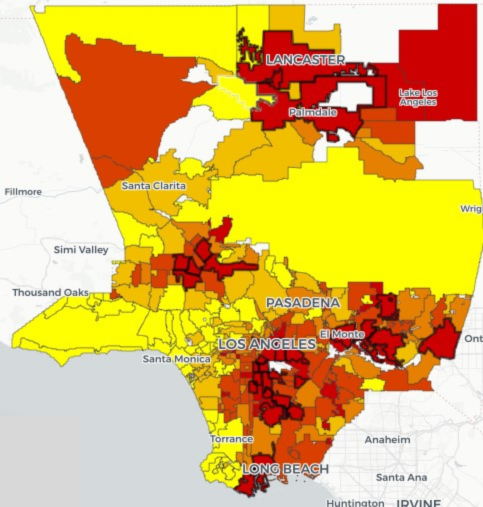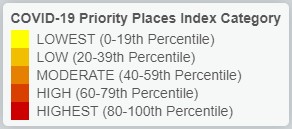After finding strong evidence for the virus’ unequal impact by race, class, and place, Catalyst California and RACE COUNTS has developed an index to help identify the communities most disproportionately impacted by COVID-19 and at great risk of adverse outcomes.
The following includes Catalyst California and RACE COUNTS’ rankings of cities and communities in Los Angeles County, based on increases in COVID-19 case rates and the presence of vulnerable and high risk populations. These rankings identify the highest impacted communities that have had high average week-to-week increases in COVID-19 case rates AND a large proportion of vulnerable populations.
We define vulnerable populations as individuals under 200% of the Federal Poverty Level (FPL) or who are Black, Latinx, or Native Hawaiian / Pacific Islander (NHPI). We do not include measures of preexisting health conditions given the limited availability of health data by place. While the presence of preexisting health conditions plays an overwhelming role in the severity of COVID-19 illness, there is also substantial evidence that the sheer impact of COVID-19, in terms of cases and deaths, is not equal by race or class. For example, in their COVID-19 Racial, Ethnic, & Socioeconomic Data & Strategies publication, Los Angeles County Department of Public Health reports that areas with high poverty rates as well as Black, Latinx, and NHPI individuals have disproportionately high COVID-19 case rates and/or death rates. Identifying our hardest hit communities by using COVID-19 case increases as well as area poverty and race could help curb the unequal spread and impact in Los Angeles County.
Catalyst California is sharing maps and data of our current index, so community partners and county stakeholders can explore the rankings and use them as a starting point for identifying Los Angeles’ hardest hit communities. We are also including our current assessment of the top 30 priority places, defined as the 30 most populous places in Los Angeles County within the HIGHEST priority category on our index. Catalyst California and RACE COUNTS has shared the data, analysis, and visualizations of the index with our partners at the Los Angeles County Department of Health Services and the Los Angeles Department of Public Health. The Department of Health Services has conducted their own hot spot analysis that closely aligns with our analysis. In addition to this index, the Race and COVID-19 Cross Sector workgroup convened by RACE COUNTS has packaged its implementation recommendations into a memo it shared with the County of Los Angeles on July 22, 2020.
Methodology Summary
We use three factors in the index:
- average weekly percent change in COVID-19 case rate,
- percent of population living under 200% of the FPL, and
- average of Black, Latinx, and NHPI residents as a percent of population.
We calculate percentile scores for all three factors, double weight the percentile score for change in COVID-19 case rate, and average them to create an overarching composite score. We exclude places with populations less than 1,000 individuals. The use of percentile scores and component scores to create a single composite index closely relates to the CalEnviroScreen 3.0 methodology.
Download the report detailed methodology.
Top 30 Places Methodology
Using the composite index score, we calculate a percentile rank for all 302 Los Angeles County places in our index. To identify our recommended list of priority places for targeted interventions, we focus on places in the top 20th percentile of the index, which narrows to 61 places. Next, we order these places from highest to lowest population and prioritize the top 30 most populous places. In other words, the top 30 places list represents the most populous places in Los Angeles County within the Highest or top 20th percentile of impact.
Key Findings
- Places within the Highest level of impact closely mirror the places that experienced a high shift in cases early in the pandemic–including South and Southeast Los Angeles as well as parts of the San Fernando Valley, Antelope Valley, and eastern regions of the county.
- Large portions of South and Southeast Los Angeles as well as places within the eastern regions of the county fall within the Top 30 list given their high index rankings, case rates, and population numbers.
- Communities in the Antelope Valley and northeast San Fernando Valley also fall within the Highest category of impact.
- Because area race and ethnicity as a factor does not adequately capture American Indian or Alaska Native (AIAN) populations, other interventions other than using a targeted place-based approach may be needed to address growing cases among the AIAN community.


Data Sources
COVID-19 Cases: L.A. Times Data Desk, California Coronavirus Data, Place Totals. Updated on 3/25/2021. Retrieved from https://github.com/datadesk/california-coronavirus-data.
COVID-19 Cases: L.A. Times Data Desk, California Coronavirus Data, Agency Totals. Updated on 3/25/2021. Retrieved from https://github.com/datadesk/california-coronavirus-data.
Total Population, Race, and Poverty Estimates: Los Angeles County, Internal Services Department, Population and Poverty Estimates, 2018. Retrieved from https://egis3.lacounty.gov/dataportal/2014/09/09/population-and-poverty-estimates (link no longer active).
Acknowledgments
Stakeholders and partner organizations on the Race and COVID-19 Cross Sector Workgroup supported us by reviewing and providing feedback on the index:
Alberto Retana, Community Coalition
Andrea Williams, Southside Coalition of Community Health Centers
Arturo Carmona, Tzunu Strategies
Aurea Montes-Rodriguez, Community Coalition
Avianna Uribe, Los Angeles County CEO
Benjamin Torres, Community Development Technologies
Blanca Gallegos, SEIU Local 99
Bonnie Midura, The California Endowment
Caitlin Kosec, Urban Peace Institute
Carl Kemp, Los Angeles Department of Public Health
Charisse Bremond Weaver, Brotherhood Crusade
Chrissie Castro, Los Angeles City/County Native American Indian Commission
Cielo Castro, Fairplex
Clemens Hong, Los Angeles County Department of Health Services
Donna Sze, Los Angeles Department of Public Health
Efrain Escobedo, California Community Foundation
Elan Shultz, Department of Health Services, County Supervisor District 3
Eric Lam, Urban Peace Institute
Dr. Erika Flores Uribe, Los Angeles Department of Health Services
Fernando Rejon, Urban Peace Institute
Fred Ali, Weingart Foundation
Jacqueline Valenzuela, Los Angeles County Department of Public Health
Dr. James Kyle, LA Care
Jamie Schenker, California Wellness Foundation
Dr. Jan King, Los Angeles County Department of Public Health
Janel Bailey, Los Angeles Black Workers Center
Jelani Hendrix, SEIU Local 2015
Joann Guerilus, Community Coalition
Joseph Quintana, United American Indian Involvement
Joseph Villela, Coalition for Humane Immigrant Rights (CHIRLA)
Karren Lane, Weingart Foundation
Kim Patillo Brownson, Ballmer Group
Laura Cortez, East Yard Communities for Environmental Justice
Lester Garcia, SEIU Local 99
Lian Cheun, Khmer Girls In Action
Lindsey Lastra, East Yard Communities for Environmental Justice
Louise McCarthy, Community Clinic Association of Los Angeles County
Maiesha Kif, Los Angeles Urban League
Marcos Aguilar, Anahuacalmecac International Baccalaureate World School
Maria Brenes, InnerCity Struggle
Mariana Magana, Coalition for Human Immigrant Rights (CHIRLA)
Marina Acosta, LA Care
Mark Lopez, East Yard Communities for Environmental Justice
Marvin Andrade, LA Voice
Mary Lee, Consultant
Max Arias, SEIU Local 99
Michael Lawson, Los Angeles Urban League
Miguel Ramos, East Yard Communities for Environmental Justice
Miguel Santana, Fairplex
Dr. Muntu Davis, Los Angeles County Department of Public Health
Nina Revoyr, Ballmer Group
Patricia Lopez, United American Indian Involvement
Regina Wilson, California Black Media
Rosemary Veniegas, California Community Foundation
Rosie Arroyo, Callifornia Community Foundation
Dr. Sandra Chang, Los Angeles County Department of Mental Health
Sarine Pogosyan, Community Clinic Association of Los Angeles County
Sevly Snguon, Children’s Defense Fund – California
Shimica Gaskins, Children’s Defense Fund – California
Suzette Aguirre, East Yard Communities for Environmental Justice
Taylor Thomas, East Yard Communities for Environmental Justice
Zach Hoover, LA Voice
Research and data analysis by Leila Forouzan, Ryan Natividad, and Elycia Mulholland Graves with support from Chris Ringewald and Rob Graham.
Design and data visualization by Katie Smith, Ryan Natividad, and Rob Graham.
Conceptualization and editing support from Maria Cabildo, Matt Trujillo, and John Kim.